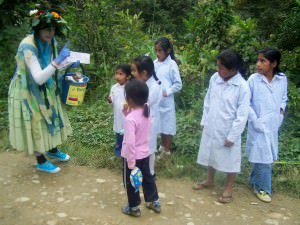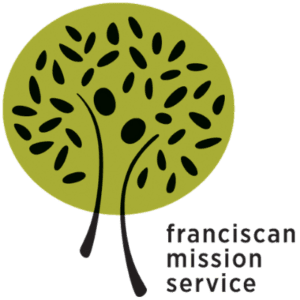The Earth Day that Pachamama led an anti-litter campaign
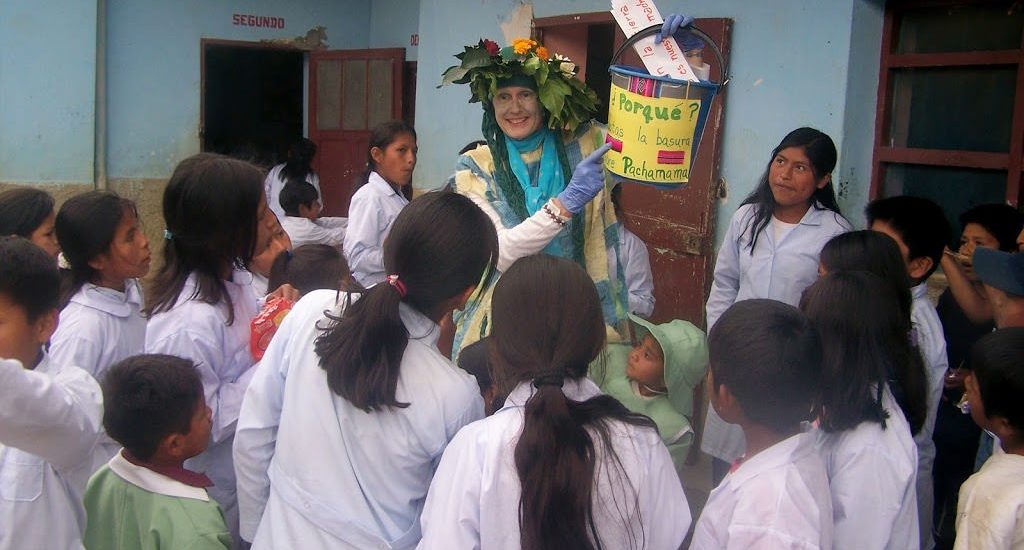
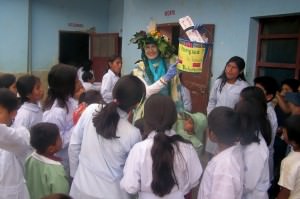 |
| Missioner Jean Lechtenberg dressed up as Pachamama for Earth Day 2008 in Carmen Pampa, Bolivia |
To the indigenous peoples of the Andes, everything is inhabited by spirits – rocks, trees, mountains – but Pachamama is the earth itself. She is the source of all life, fruit, grain, springs of water, and the mineral riches of the earth. She is second in the Inca pantheon only to Inti the Sun God.
Still today in Bolivia, one does not take a drink of beer or native corn chicha without pouring a bit into the earth – “para Pachamama.” So it goes without saying that the indigenous people treasure and respect the earth.
And yet in recent times they are awash with trash. Traditionally when a campesino ate an orange or banana on the trail the skins were tossed aside. Chicken bones went behind the house. But now, it is plastic containers, candy wrappers, and bottles being tossed aside. It is jarring to see rubbish thrown from the bus windows while traveling through the majestic Andes mountain passes.
“As Franciscan Missioners, I think we were tuned into care for the environment. St. Francis calling the elements Brothers and Sisters reinforces concepts that are held by the indigenous peoples,” said Jean Lechtenberg, who served in Carmen Pompa, Bolivia from 2007-2009. “So encouraging care of the earth in practical ways such as recycling or not littering seems a natural follow up.”
For Earth Day 2008, Jean thought about portraying Pacha Mama in order to educate people about littering. However, Jean wanted to be very sensitive in dramatizing such a prominent in Andean cosmology, so she spoke to old members of the community. “I was assured that it would not be an insult,” she said.
What does Pachamama look like? She was sculpted in the 1500s by native carvers as the abundant mother from whose lap all plants draw life. Then, with Spanish Christianity, Pacha Mama became identified with the Virgin Mary who was painted with a cloak the mountain of silver in Potosi. If you ask rural people today what Pachamama looks like, many would say like the pyramid-shaped, gem covered statue of the Virgin in the town church.
So Jean was left to invent her reenactment, raiding the cabinets of the volunteers’ house for materials. She decided Pachamama would wear the familiar wide-hipped “chola” skirt and green braids framing her lovely green face. Pachamama would, of course, have green-dyed canvas shoes. She would not speak with a “gringa accent” – better that she mime and use signs.
“I remember her venturing out on the one road through town with a little trepidation,”her husband Lee Lechtenberg said. But soon, like the piper, she had a score of little children swirling after her down the road picking up litter for her bucket.
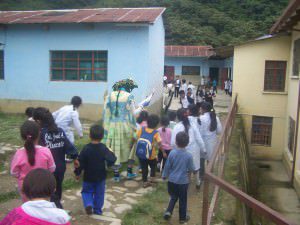 |
| Children help Pachamama/Jean Lectenberg pick up litter |
She gathered teachers and children in the school compound. She went up to the college and dropped in on classes and offices and students practicing dance steps. Faculty members wanted their picture taken with Pachamama. Bolivian people love pageantry.
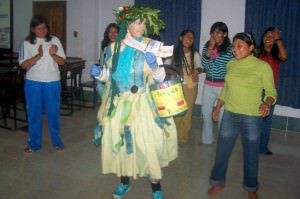 |
| Pachamama/Jean dancing with students |
“The teachers at the high school were enthusiastic,” Jean said. “And one of the college professors asked me to do some more of this kind of theater with other Aymaran figures.”
“Even though I had asked an Aymaran how my idea would be received by the people, I was a little nervous. But the delight – the acceptance and the warmth – that I felt from the youngsters, the high schoolers, the college kids and the older community members made for a memorable experience.
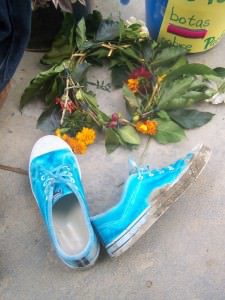 |
| The greenery for Pachamama’s crown came from the coffee plants on campus |
Dona P— probably the oldest community member – was sitting outside combing out her waist long hair and braiding it. She took a hold of my green cloth braids and chuckled – perhaps wondering why these gringas don’t grow their own braids. We just laughed together.”
At the end of the day, a tired Pachamama doffed her muddy turquoise shoes and flower crown feeling like she had finally succeeded in making her point, “Don’t throw garbage on your mama.”
Thank you to Jean and Lee Lechtenberg for their service and for contributing to this post.
Tagged in:

